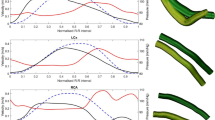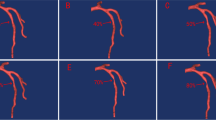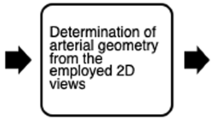Abstract
It remains unknown that the degree of bias in computational fluid dynamics results without considering coronary cyclic bending. This study aims to investigate the influence of different rates of coronary cyclic bending on coronary hemodynamics. To model coronary bending, a multi-ring-controlled fluid–structural interaction model was designed. A coronary artery was simulated with various cyclic bending rates (0.5, 0.75 and 1 s, corresponding to heart rates of 120, 80 and 60 bpm) and compared against a stable model. The simulated results show that the hemodynamic parameters of vortex Q-criterion, temporal wall shear stress (WSS), time-averaged WSS (TaWSS) and oscillatory shear index (OSI) were sensitive to the changes in cyclic rate. A higher heart rate resulted in higher magnitude and larger variance in the hemodynamic parameters. Whereas, the values and distributions of flow velocity and relative residence time (RRT) did not show significant differences between different bending periods. This study suggests that a stable coronary model is not sufficient to represent the hemodynamics in a bending coronary artery. Different heart rate conditions were found to have significant impact on the hemodynamic parameters. Thus, cyclic bending should be considered to mimic the realistic hemodynamics in future patient-specific coronary hemodynamics studies.









Similar content being viewed by others
References
Broyd C, Davies J, Escaned J, Hughes A, Parker K (2016) Wave intensity analysis and its application to the coronary circulation. Global Cardiol Sci Practice 2015(5):64. https://doi.org/10.5339/gcsp.2015.64
Eslami P, Tran J, ** Z, Karady J, Sotoodeh R, Lu MT, Hoffmann U, Marsden A (2020) Effect of wall elasticity on hemodynamics and wall shear stress in patient-specific simulations in the coronary arteries. J Biomech Eng 142(2):0245031–02450310. https://doi.org/10.1115/1.4043722
Fan R, Tang D, Yang C, Zheng J, Bach R, Wang L, Muccigrosso D, Billiar K, Zhu J, Ma G et al (2014) Human coronary plaque wall thickness correlated positively with flow shear stress and negatively with plaque wall stress: an ivus-based fluid-structure interaction multi-patient study. Biomed Eng Online 13(1):1–14. https://doi.org/10.1186/1475-925X-13-32
Freidoonimehr N, Chin R, Zander A, Arjomandi M (2022) A review on the effect of temporal geometric variations of the coronary arteries on the wall shear stress and pressure drop. J Biomech Eng 144(1):010801. https://doi.org/10.1115/1.4051923
Hasan M, Rubenstein DA, Yin W (2013) Effects of cyclic motion on coronary blood flow. J Biomech Eng 135(12):121002. https://doi.org/10.1115/1.4025335
Himburg HA, Grzybowski DM, Hazel AL, LaMack JA, Li XM, Friedman MH (2004) Spatial comparison between wall shear stress measures and porcine arterial endothelial permeability. Am J Physiol-Heart Circ Physiol 286(5):H1916–H1922. https://doi.org/10.1152/ajpheart.00897.2003
Prosi M, Perktold K, Ding Z, Friedman MH (2004) Influence of curvature dynamics on pulsatile coronary artery flow in a realistic bifurcation model. J Biomech 37(11):1767–1775. https://doi.org/10.1016/j.jbiomech.2004.01.021
Soulis JV, Lampri OP, Fytanidis DK, Giannoglou GD (2011) Relative residence time and oscillatory shear index of non-newtonian flow models in aorta. In: 2011 10th international workshop on biomedical engineering, IEEE, pp 1–4. https://doi.org/10.1109/IWBE.2011.6079011
Tang D, Yang C, Kobayashi S, Zheng J, Woodard PK, Teng Z, Billiar K, Bach R, Ku DN (2009) 3d MRI-based anisotropic FSI models with cyclic bending for human coronary atherosclerotic plaque mechanical analysis. J Biomech Eng 131(6):061010. https://doi.org/10.1115/1.3127253
Tang D, Yang C, Zheng J, Woodard PK, Billiar K, Teng Z, Bach R (2009) 3d in vivo IVUS-based anisotropic FSI models with cyclic bending for human coronary atherosclerotic plaque mechanical analysis. In: Summer Bioengineering Conference, vol 48913. American Society of Mechanical Engineers, pp 181–182. https://doi.org/10.1115/SBC2009-204700
Torii R, Keegan J, Wood N, Dowsey A, Hughes A, Yang G, Firmin D, Mcg Thom S, Xu X (2009) The effect of dynamic vessel motion on Haemodynamic parameters in the right coronary artery: a combined MR and CFD study. British J Radiol 82(1):S24–S32. https://doi.org/10.1259/bjr/62450556
Torii R, Wood NB, Hadjiloizou N, Dowsey AW, Wright AR, Hughes AD, Davies J, Francis DP, Mayet J, Yang GZ et al (2009) Fluid-structure interaction analysis of a patient-specific right coronary artery with physiological velocity and pressure waveforms. Commun Numer Methods Eng 25(5):565–580. https://doi.org/10.1002/cnm.1231
Wang J, Paritala PK, Mendieta JB, Komori Y, Raffel OC, Gu Y, Li Z (2020) Optical coherence tomography-based patient-specific coronary artery reconstruction and fluid-structure interaction simulation. Biomech Model Mechanobiol 19(1):7–20. https://doi.org/10.1007/s10237-019-01191-9
Zeng D, Ding Z, Friedman MH, Ethier CR (2003) Effects of cardiac motion on right coronary artery hemodynamics. Ann Biomed Eng 31(4):420–429. https://doi.org/10.1114/1.1560631
Zeng D, Ethier C (2003) A mesh-updating scheme for hemodynamic simulations in vessels undergoing large deformations. J Eng Math 47(3):405–418. https://doi.org/10.1023/B:ENGI.0000007968.02446.91
Acknowledgments
Computational resources and services used in this work were provided by the HPC and Research Support Group, Queensland University of Technology (QUT), Brisbane, Australia. As the receiver of Roland Bishop Award, Dr. Jiaqiu Wang would like to thank the Bishop family for their generous support of Biomedical Engineering Research.
Funding
This work was partially supported by the National Natural Science Foundation of China (Grant Nos. 12172089, 11972118, 61821002), the Australian Research Council (ARC) (Grant Number DP200103492), the Medical Research Future Fund (2016165), and the Early Career Researcher Grant funded by Centre for Biomedical Technologies.
Author information
Authors and Affiliations
Contributions
J.W. designed the study, setup the computational work, processed data and wrote the manuscript. R.F. and H.W. prepared figures 2-8. Y.X. processed the statistics. J.M., H.A., J.C. and P.P. participated on designing the study plan. Z.F. optimized the simulation setup. O.R. provided clinical insight on the results discussion. Z.L. supervised the study. All authors reviewed the final manuscript.
Corresponding authors
Ethics declarations
Conflict of interest
The authors declare that they have no conflict of interest.
Rights and permissions
Springer Nature or its licensor (e.g. a society or other partner) holds exclusive rights to this article under a publishing agreement with the author(s) or other rightsholder(s); author self-archiving of the accepted manuscript version of this article is solely governed by the terms of such publishing agreement and applicable law.
About this article
Cite this article
Wang, J., Fang, R., Wu, H. et al. Impact of cyclic bending on coronary hemodynamics. Biomech Model Mechanobiol 22, 729–738 (2023). https://doi.org/10.1007/s10237-022-01677-z
Received:
Accepted:
Published:
Issue Date:
DOI: https://doi.org/10.1007/s10237-022-01677-z




